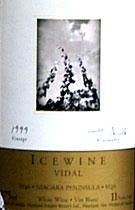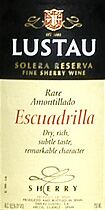|
More from Canada: Icewine
Wednesday's report on the Mission Hill wines from British Columbia drew an unexpectedly large response, including quite a few E-mails from delighted Canadians and a similar number from wine enthusiasts in the U.S. and elsewhere around the world who share my wish that Canadian wine wasn't so doggone difficult to find. Quite a few of you also sent a similar request: "Tell us about Canadian icewine!" Well, all right. Originally a rare German treat called "Eiswein," which is pronounced "Ice-vine," sounding a lot more like its English translation than it looks, icewine has been joyously adopted by Canadian wine makers - particularly in Ontario's Niagara Peninsula but also in the Okanagan Valley of British Columbia and elsewhere - and has become the one Canadian wine export that's widely known and respected, if only rarely actually seen and tasted, around the rest of the world. It's made by allowing ripe grapes to remain hanging on the vines long after the usual harvest time, then bringing them in after the season's first hard freeze and pressing out their juice while the fruit is still frozen. The freezing concentrates all the fruit sugar and much of its "physiologically mature" flavor into just an intense drop or two from each grape, resulting in a tiny quantity of fantastically sweet wine. Virtually all German Eiswein and a good share of Canadian icewine is made from the noble Riesling grape; Canada has also made good use of the French-American hybrid Vidal, which in my experience makes a less "earthy" but very clean and luscious icewine. A bit of red icewine is made from Cabernet Franc, and at least one Ontario producer, Inniskillin, makes a sparkling icewine that's extremely expensive and, how can I describe it, deliciously bizarre. True icewine can be made only in a few parts of the world where the summers are long enough and mild enough for wine grapes to thrive, yet where winters are cold enough to bring rock-hard winter freezes, but without being so cold that vines die back to their roots. This odd three-way climate combination seems to be most likely in places along the extreme northern edge of the temperate zones where wine grapes can grow, typically in regions like Niagara and the Okanagan, New York's Finger Lakes and Germany's Rhein and Mosel valleys, where bodies of water provide cooling in the summertime and offer a bit of frost protection in winter. A few producers in more balmy climates have sought to get in on the icewine excitement by freezing late-harvested grapes in commercial freezers. Regulations in most countries forbid calling this product "icewine," a restriction that the wits at California's Bonny Doon avoid by calling their freezer wine "Vin de glaciere," or "refrigerator wine." Wine experts argue whether there's any perceptible difference between natural icewine and this freezer-made product, but the conventional wisdom holds that the real thing gains earthy complexity from the grapes' extended "hang time" on the vines, which allows ample time for the fruit to achieve full "physiological maturity." While we're on the subject of Canadian wine, you may have noticed an unfamiliar acronym attached to both today's and Wednesday's featured wines: VQA, short for "Vintner's Quality Alliance," is a certification - akin to the French AOC or Italian DOC - that Canadian producers may seek. Its presence on the label guarantees that the grapes used in the wine were grown within the geographical area and that the wine was taste-tested by a panel to ensure that it met standard for that region's wines. It should be noted that VQA status is optional, and I'm told that many of Canada's top artisanal producers don't seek it.
WEB LINKS: Today's wine report features an attractive Vidal icewine that was given me by a Canadian vine-grower friend who went along on our Bordeaux tour last summer. We enjoyed it last autumn but I hadn't reported on it heretofore because it was a gift, and because it's not likely to be easy for most if you to find. It seemed appropriate to feature it today, though, in the hope that you'll enjoy at least a "virtual" tasting on this topic; Canadian readers, at least, should be able to order it direct from the winery, and source material is provided in my tasting report in the event others wish to try to track it down. I've also added a bonus report on a rich but dry Amontillado that should be more available, and more affordable.
TALK ABOUT WINE ONLINE If you prefer to comment privately, feel free to send me E-mail at wine@wineloverspage.com. I'll respond personally to the extent that time and volume permit.  Vineland Estates Winery 1999 Niagara Peninsula Vidal VQA Ice Wine
Vineland Estates Winery 1999 Niagara Peninsula Vidal VQA Ice Wine
This brilliant, bright-gold wine almost shimmers in the glass. Apricot and pretty aromas, accented with grace notes of wildflowers and spice, gain intensity with swirling. Intensely sweet, unctuous in texture; gentle acidity builds structure in a very long finish. I don't find remarkable complexity here or much of the earthy ripeness that attends the finest late-harvested wines, but its luscious fruit sugars and fresh acid balance make a lovely wine-as-dessert experience. Importer: Gift, personally hand-carried. (Sept. 10, 2003) FOOD MATCH: Best sipped by itself, contemplatively, possibly with a piece of perfectly ripe fruit for contrast. VALUE: Limited supply and substantial demand ensure that ice wine is not cheap. The winery retail price - $39.95 Canadian for a 375 ml half-bottle (about $30 U.S.) - is well within the expected range for ice wine, and for fine dessert wines of any description. WHEN TO DRINK: Canadian ice wine is still a new-enough niche that the jury remains out regarding their long-term ageworthiness; but the long record of other extremely sweet dessert wines suggests that intriguing complexity and increasing richness may come with careful cellaring.
WEB LINK: There's plenty of content on the Vineland Website,
FIND THIS WINE ONLINE: See "Buy our Wine" on the winery Website, or check prices and find vendors for Vineland Icewine on Wine-Searcher.com: Now, recognizing that most of us may have a hard time finding Canadian icewines or dubious about making the expenditure, here's something completely different, a bone-dry but warming Amontillado to follow up on my recent (Feb. 2 and Feb. 4) Sherry reports.  Lustau Rare Amontillado Escuadrilla ($15.99)
Lustau Rare Amontillado Escuadrilla ($15.99)
Clear bronze-amber color, not too dark. Pleasant fresh-cracked pecan scents gain complexity from a whiff of the aroma that Sherry experts call "rancio," an earthy but pleasant character akin to overripe fruit. Mouth-filling but bone-dry, butter-pecan, alcoholic warmth and tart, tangy lemon-squirt acidity come together in balance to make a fine after-dinner sipper. U.S. importer: Europvin USA, Oakland, Calif., selected by Christopher Cannan. (March 2, 2004) FOOD MATCH: Best enjoyed by itself after dinner, although a bowl of cracked nuts and a wedge of blue cheese would not be amiss. VALUE: Appropriate price. WHEN TO DRINK: Won't evolve with age but can be kept almost indefinitely in the cellar or wine rack.
WEB LINK: Emilio Lustau's English-language Website is here:
FIND THIS WINE ONLINE: Click "Buying Lustau Sherry" on the winery Website for distributor information; you can also find Lustau Escuadrilla on Wine-Searcher.com:
SUBSCRIBE: Administrivia To subscribe or unsubscribe from The 30 Second Wine Advisor, change your E-mail address, or for any other administrative matters, please use the individualized hotlink found at the end of your E-mail edition. If this is not practical, contact me by E-mail at wine@wineloverspage.com, including the exact E-mail address that you used when you subscribed, so I can find your record. We do not use our E-mail list for any other purpose and will never give or sell your name or E-mail address to anyone. I welcome feedback, suggestions, and ideas for future columns. To contact me, please send E-mail to wine@wineloverspage.com All the wine-tasting reports posted here are consumer-oriented. In order to maintain objectivity and avoid conflicts of interest, I purchase all the wines I rate at my own expense in retail stores and accept no samples, gifts or other gratuities from the wine industry.
Friday, March 5, 2004 |




